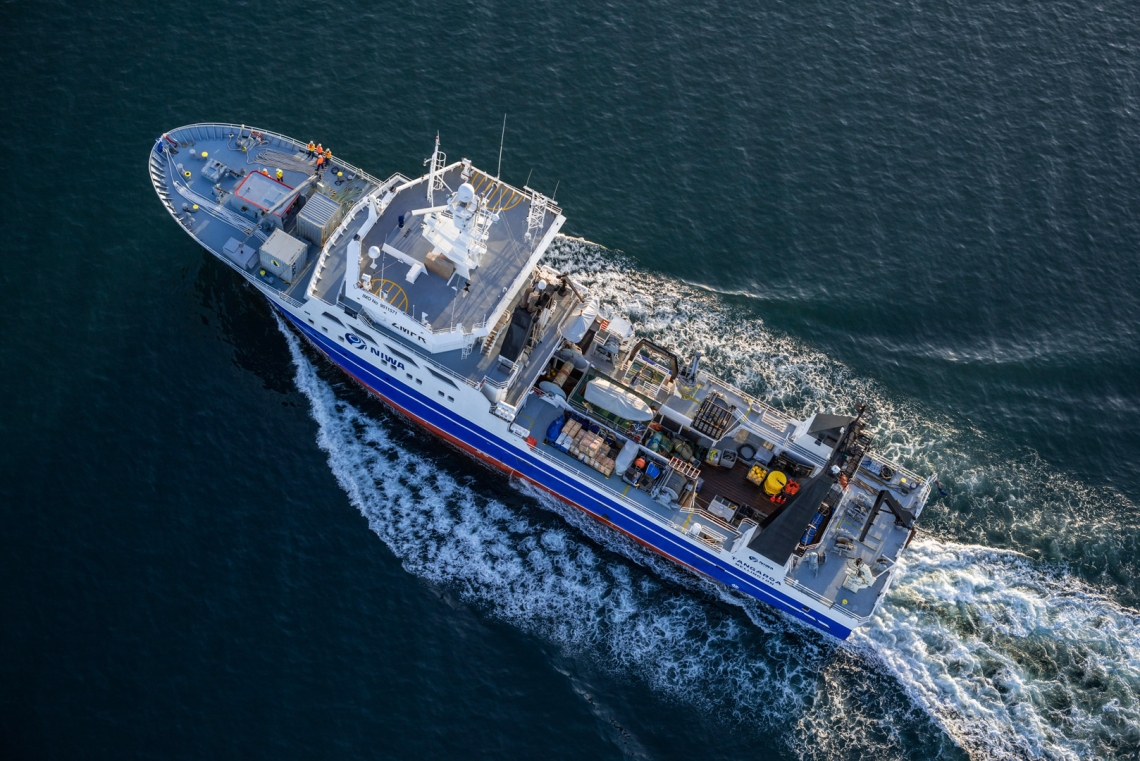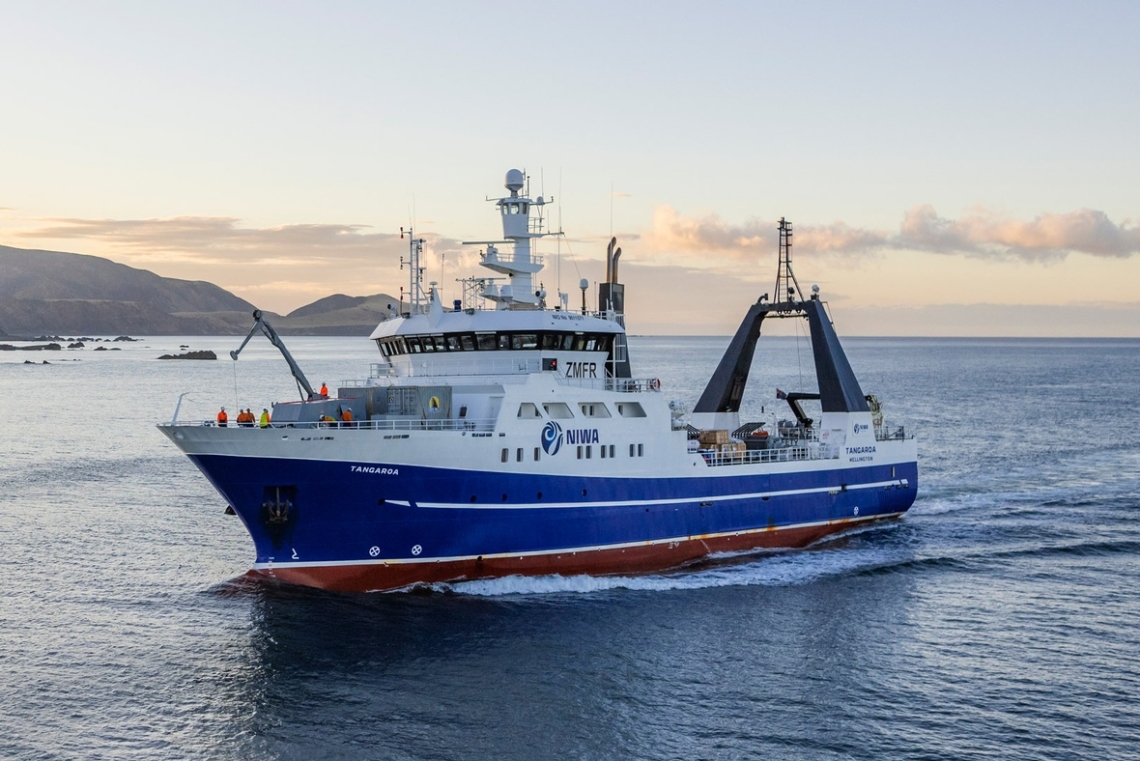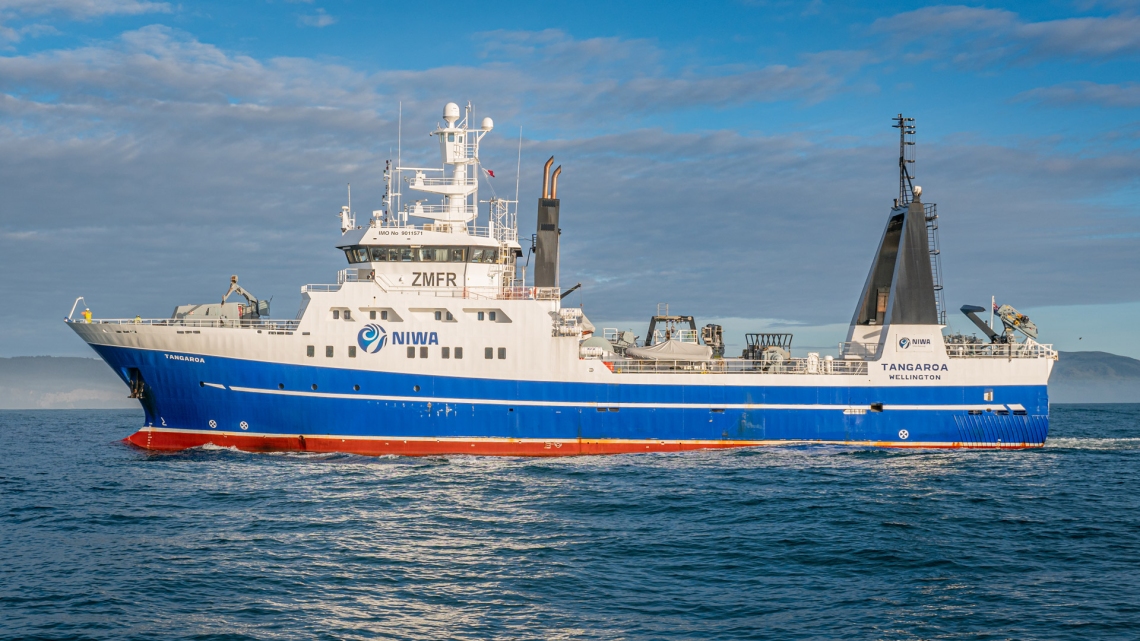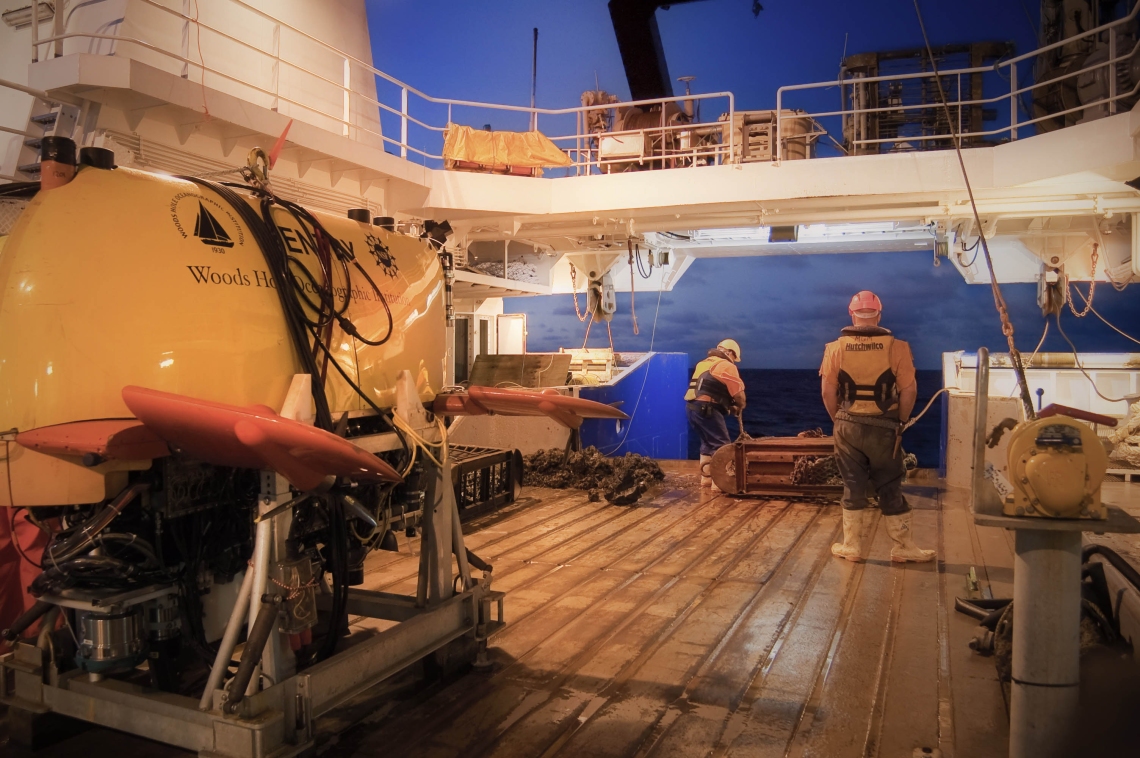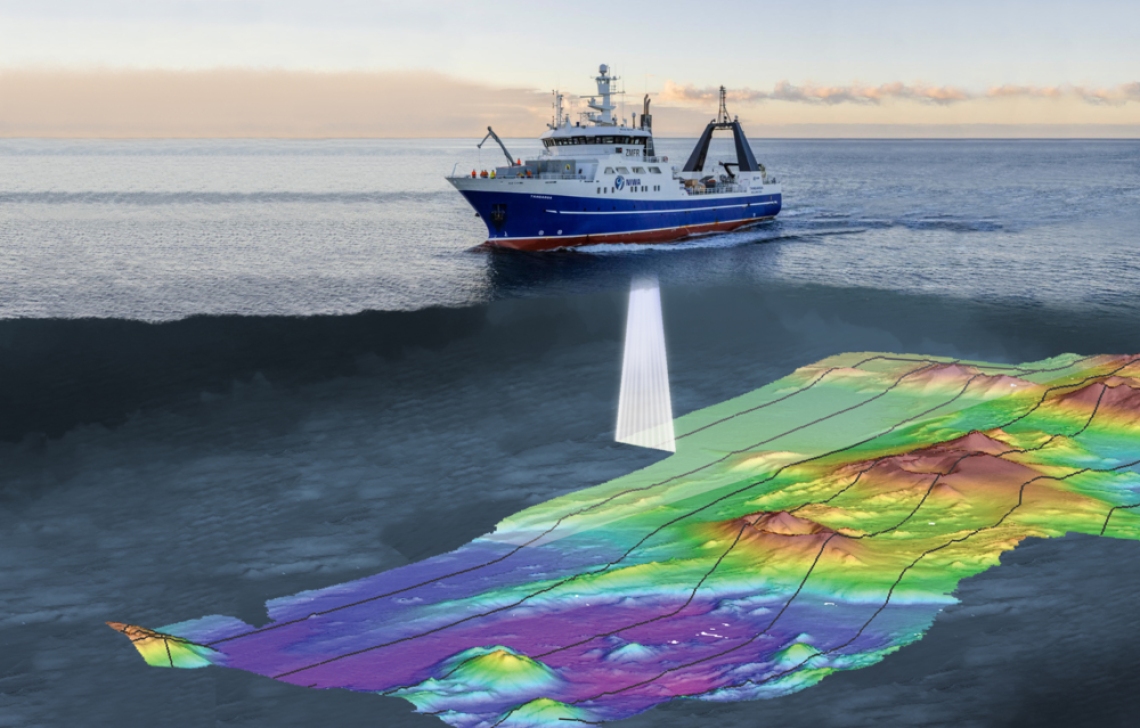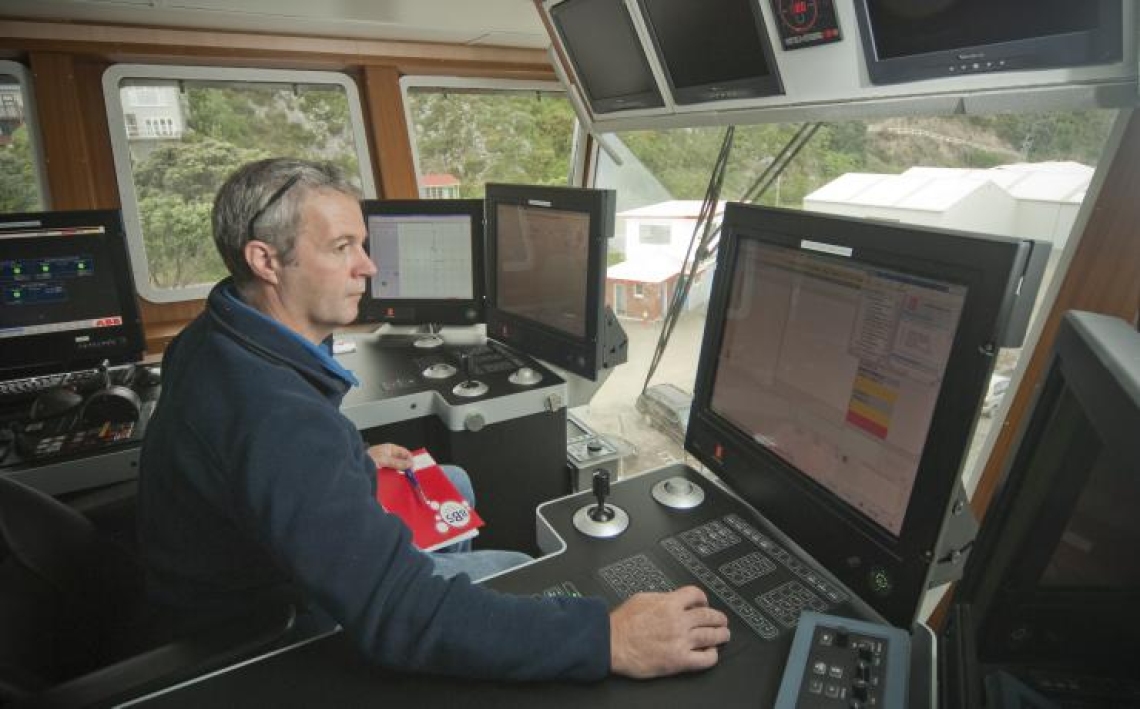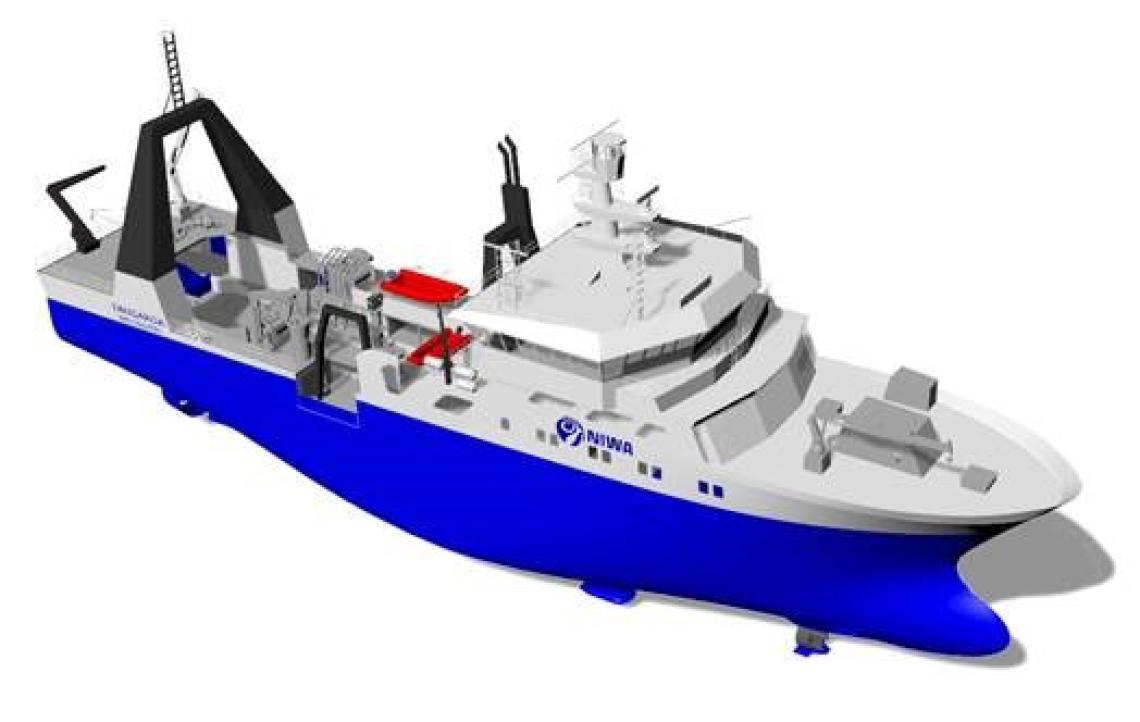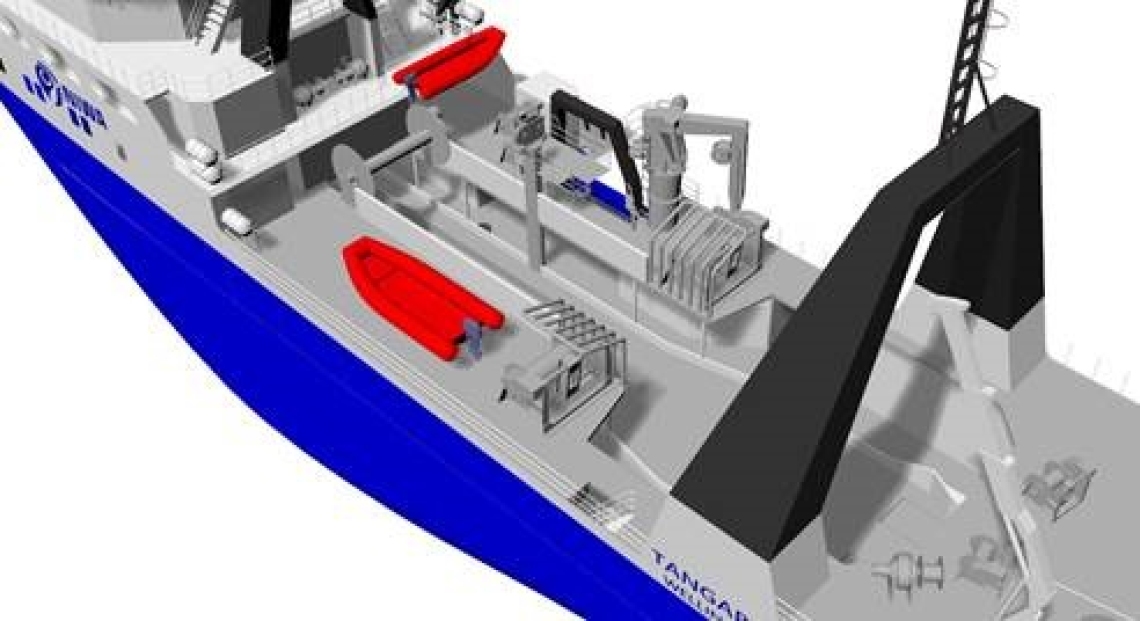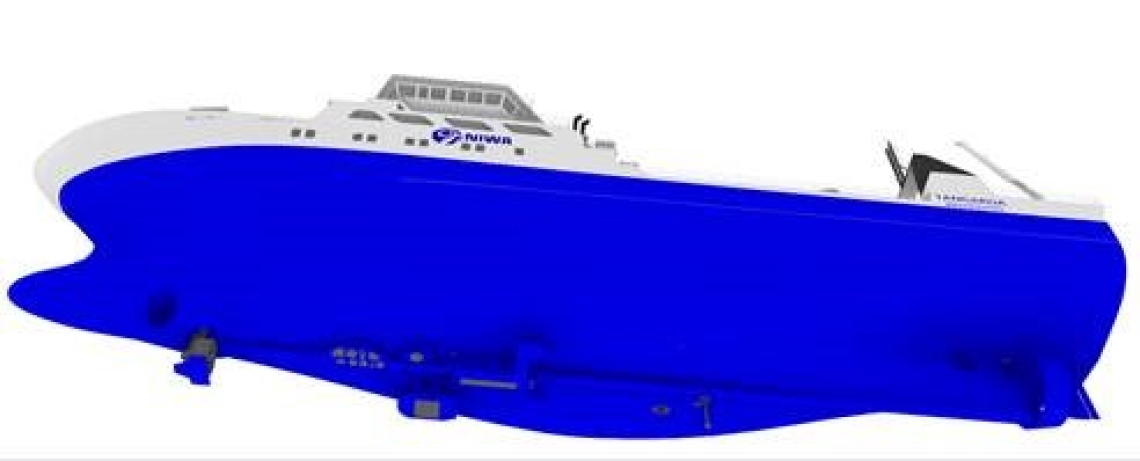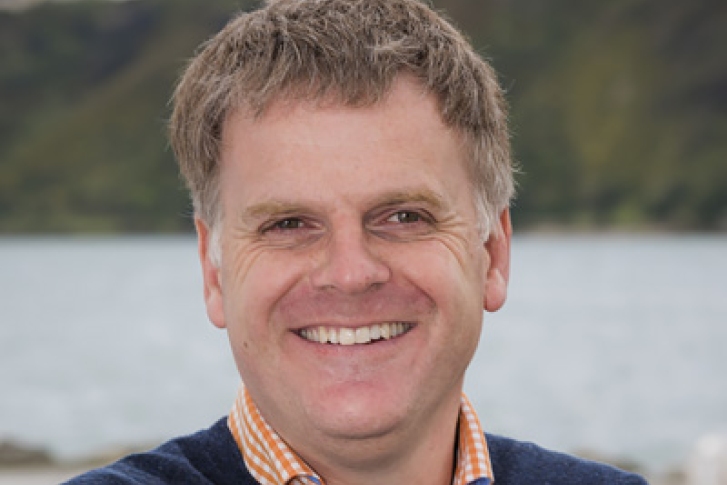RV Tangaroa is New Zealand’s only ice strengthened and dynamically positioned deep-water research vessel.
Equipped for ocean science, exploration and marine engineering, Tangaroa provides a sophisticated environmental survey and ocean science platform throughout the South Pacific, Southern Ocean and Antarctica.
The vessel is equipped with a range of modern and sophisticated equipment enabling sampling and measurements to be taken from the sea surface, through the water column to the seabed and below.
Specifications and features
General
| Name of vessel | RV Tangaroa |
| Owner | NIWA Vessel Management Limited |
| Flag | New Zealand |
| Call sign | ZMFR |
| Port of registry | Wellington |
| Classification | DNV – 1A1 (stern trawler/research vessel) + Ice 1C (light ice: ice floes up to 0.4 metres thick) |
| Year of construction | 1991 – Mjellem & Karlsen Verft, Norway |
| Length | 70.0 metres |
| Beam | 13.8 metres |
| Draft | 7.0 metres |
| Hull | Steel displacement, ice-strengthened |
| Gross tonnage | 2291 tonnes |
| Nett tonnage | 687 tonnes |
| Cruising speed | 10.5 knots |
| Main engines | Wartsila Vasa 8R 32D 4023 bhp (2,999 kW) |
| Shaft generator | Leroy Sommer 900 kVA |
| Main generators | 2 x Cummins QSK60 1800 kW (1,440 kWe) |
| Harbour generator | Scania DI13074M Stanford S4L1M 400kVA Propeller: Wartsila Wichman PR 90/4 |
| Propeller | Wartsila Wichman PR 90/4 |
| Bow thruster | Brunvoll 600 kW CPP |
| Stern thruster | Brunvoll 800 kW CPP |
| Retractable azimuth | Brunvoll 800 kW CPP |
| Freshwater capacity | 40 cubic metres |
| Water maker | 4-14 cubic metres per 24 hours (approx) |
| Fuel capacity | 620 cubic metres |
| Accommodation | 22 single berths with ensuite 9 double berths with ensuite |
| Endurance | 60 days |
| Rescue boat | Rigid bottom inflatable SOLAS |
| Work boat | 5.8 metre Naiad inflatable SOLAS |
| Medical room | Hospital with basic medical facilities |
Electronic equipment
| Electrical supply | 50 and 60 Hz |
| Dynamic positioning (DP) system | Kongsberg KPOS DP21 |
| Positioning | SeaStar 9200 XP DGPS MarineStar 9205 GT DGPS |
| Joystick controller | Kongsberg c-Joy |
| Acoustic positioning system | Kongsberg HiPAP 500 USBL with 4750 hull unit |
| Side scan sonar | C-MAX CM2 side scan sonar |
| Subbottom profiler systems | Kongsberg TOPAS PS 18 Geo Acoustics profiler boomer |
| Transponders | Kongsberg MST319N with float Kongsberg MST432N |
| Gyro | Sperry Marine Navigat X MK 1 (3) |
| Motion reference units | Kongsberg MRU-5 Kongsberg MRU-D Kongsberg MRU-2 |
| GPS | Seastar 9200 DGPS Seastar 8200 DGPS Leica MX420 Furuno GP31 Furuno GP150 |
| Wind sensors | Gill Windobservor II Ultrasonic (2) |
| Autopilot | Robertson AP 9 MK3 |
| Electro-magnetic log | Sperry Marine Naviknot 350E |
| Net monitors | Scanmar system Furuno CN22 Kaijo Denki |
| Radars | Sperry Marine Bridgemaster ARPA 183 S band radar SAAB AIS system Koden MDC-1810P/1820 X band |
| Video plotter | Seaplot Pro |
| Graphic plotter | Epson Stylus 7800 A1 plotter |
| Echo sounders (ship) | Kongsberg Simrad EM 302 multi beam sounder, 30 kHz Kongsberg Simrad EA 600 hydrographic sounder, 12 and 120 kHz Kongsberg Simrad ES 60 fisheries sounder, 27 kHz Kaijo Denki KMC 2000, 24 and 200 kHz Simrad EK60 scientific sounder, 18, 38, 70, 120, and 200 kHz |
| Weather fax | Furuno Fax. 30 |
| Meteorological station | Automatic weather station |
Communication facilities
| Starlink | High-speed internet around the globe |
| Cell phone Fax | +64 27 442 7510 – Bridge, when in range of the Telecom NZ network +64 27 236 4966 |
| Fleet 77 Voice Fax e-mail | 008 707 646 32684 008 707 646 32685 [email protected] |
| Satcom system C e-mail | Thrane & Thrane 3020A [email protected] |
| Main radio | Furuno FS1562 – (GMDSS compliant) |
| VHF | Furuno FM8500 (x2) – (GMDSS compliant) |
| Watch receiver | Furuno AA50 – (GMDSS compliant) |
| Data system | Ifremer Techsas Underway Data Acquisition System & SDIV+ displays |
| Intercom system | Vingtor KCN 300 |
Main trawl/Net winches
All the permanent winches are supplied by Rolls-Royce (Hydraulic Brattvagg).
| 2 Main trawl winches – 2,500 to 4,000 metres, 28mm 6x19 wire rope, self tensioning |
| 2 Gilson winches |
| 4 Sweepline winches |
| 1 Outhaul winch |
| 1 Codend winch |
| 1 windlass |
| 2 Net drum winches |
Scientific winches
| 2 Acoustic winches | Each can hold 1,200 metres, 12.5 mm faired cable or 2,000 metres, 12.5 mm faired, slip ring (12 analogue plus 2 optical channels) fitted |
| Hydrology winch | 2,000-3,000 metres 6 mm wide |
| Deep ocean winch | 10,000 metres, 16 mm cable, or up to 28 mm wire diameter, maximum pull 23 tonnes |
| CTD winch | 8,000 metres, 10.5 mm cable, slip ring (12 analogue plus 2 optical channels) fitted. |
| Camera winch | 2,000-3,000 metres, 15.1 mm cable, slip ring (12 analogue plus 2 optical channels) fitted. |
Lifting equipment
| 2 Seacranes | Stern: Seacrane, 2 tonnes; bow (Palfinger), 2 tonnes |
| 1 Seacrane | Midships (Effer) 15 tonnes |
| A-Frame | Starboard mounted. Lifting capacity 10 tonnes. Deck clearance 6 metres, width between legs 3.2 metres |
| A-Frame | Port mounted. Lifting capacity 8.5 tonnes. Deck clearance 6 metres, width between legs 11.2 metres |
| J-Frame | Stern mounted. Lifting capacity 1.5 tonnes. |
Hydrographic sounders
| Single-beam echo sounders | Simrad EK 500 (Scientific): 12, 27, 38 and 120 kHz Simrad EA 500 (Hydrographic): 12 and 120 kHz |
| Multi-beam echo sounders | SIMRAD EM300: 30 kHz SIMRAD EM3002: 3000 kHz |
| Survey navigation systems | HydroPro and HydroMap |
| Motion compensation | TSS DMS TSS POSMV system |
| Sound velocity calibration | Expendable Bathythermographs (XBTs) Digibar DB-1100 AML SVplus sound velocity profiler |
Automatic weather station
Tangaroa carries sensors for wind speed and direction, barometric pressure, relative humidity and air temperature and solar radiation, sea-surface temperature, while other sensors can be provided as requested.
Virtual tour
Scientific work areas and laboratories
CTD enclosure
The CTD (conductivity-temperature-depth) profilers are deployed through the mid-ships starboard A-frame. When it is recovered, the CTD profiler is then housed in the CTD-enclosure, which is connected to the hydro/dry-laboratory.
Wet laboratories
Tangaroa has excellent facilities for the sorting, preserving, processing, and storage of fish, plankton, and other biological material. These include several purpose-built wet laboratories. Two laboratories are on the starboard side on the main trawl deck; one commonly used as a CTD-laboratory or as a wet hydro-lab (5.7 m x 1.5 m), the other a plankton lab (4.7 m x 1.7 m). A sizable temperature-controlled wet laboratory (3.4 m x 3.0 m) is also provided on the starboard side of the trawl deck. All laboratories have workbenches, cold and warm running water, and ample space for storage of containers and equipment.
Fish sorting and processing
The trawl is emptied onto the deck and the fish stored through hatches in three receiving bins (total capacity: 75 m3), where they are kept fresh by a refrigerated salt water re-circulation system. Upon removal from a receiving bin, the fish is sorted semi-automatically by hand, with the selected specimen kept in smaller holding tanks for further scientific study. The remaining fish are processed in the fish factory, which can process up to 16 tonnes of fish per day. The freezer hold has a capacity of 350 tonnes of processed fish product.
Three laboratories are available on the fish-processing deck. The main wet laboratory (6.2 m x 7.1 m) contains large weighing and dissecting tables and is used for all major fish studies. Two more laboratories are available - one wet laboratory (4.2 m x 3.2 m) and one dry laboratory (3.5 x 3.2 m).
A medium-sized scientific freezer, adjacent to the main wet laboratory, is designed to remain at a constant temperature between –30 and +5°C.
Dry laboratories and computer areas/rooms
Tangaroa has five dedicated dry laboratories/computer areas. There is a large computer area (6.5 m x 4.1 m) on the bridge, from which voyage leaders, lead scientists, and support staff can direct all scientific operations and process the main data.
One hydro/dry laboratory (6.0 m x 3.2 m) is available on the trawl deck, while one terminal room (4.5 m x 4.5 m) is provided on the main deck. The main computer/EM300 control room (4.5 m x 5.7 m) and the electronics laboratory (4.5 m x 6.0 m) are housed below the main deck.
Dark room
The vessel’s dark room (5.5 m x 2.5 m) is situated on the trawl deck.
Radioisotope laboratory
The chemical preparation and storage laboratory can be used as a radioisotope laboratory (3.2 m x 2.8 m). It is located on the trawl deck, and is provided with benches and fume cabinet.
Temperature-controlled laboratory
The port wet lab, on the trawl deck, can maintain a controlled temperature between –5 °C and +5 °C (with an accuracy of plus/minus 1.0 °C).
Container laboratories
Tangaroa can carry up to three six metre container laboratories on the trawl deck.
Emergency survival container
Tangaroa is also fitted with a six metre emergency survival container. This container is designed to provide all basic survival facilities and food for the entire vessel’s complement, should the vessel experience a total ‘black-out’, i.e., no engine power.
Communal areas
Tangaroa has a range of communal spaces available, including:
- Mess room
- Three lounges with television and video facilities (one is a smoking lounge)
- Conference room (6.7 m x 3.2 m) that seats 14 personnel
- Ship’s office (3.1 m x 3.2 m)
- Fitness centre
- Japanese bath
- Sauna
Scientific sea water supply
The vessel has a built-in sea water pumping system with the capacity to pump approximately 30 m3 of water per hour for scientific purposes.
Additional equipment
Mobilised as required
| Multi-channel seismic system | Geometrics GeoEel 48 channel, active section length 600 metres |
| Compressors | Containerised Price SA35-W, 185 cuft/min, and containerised Reavell 5436 75.8 cuft/min @ 2,000 psi |
| Airguns array | GI-guns: 210 to 710 cuinch |
| Gravity meter | LaCoste and Romberg |
| CTD-systems | SeaBird911, 24 and 12 bottles, many sensors |
| Seabed sampling | Rock dredges and bottom corers |
| Sonobuoy system | Sparton AN/SSQ-53 |
| Sound velocity calibration | Expendable bathythermographs (XBTs) Digibar DB-1100 AML SVPlus sound velocity profiler |
| Tide measurements | Current, level, etc meters |
| ROV / AUV Systems | Support a range of classes |
The information provided on this webpage is for general informational purposes only and may be subject to change. For detailed specifications and additional information, please contact us directly.

